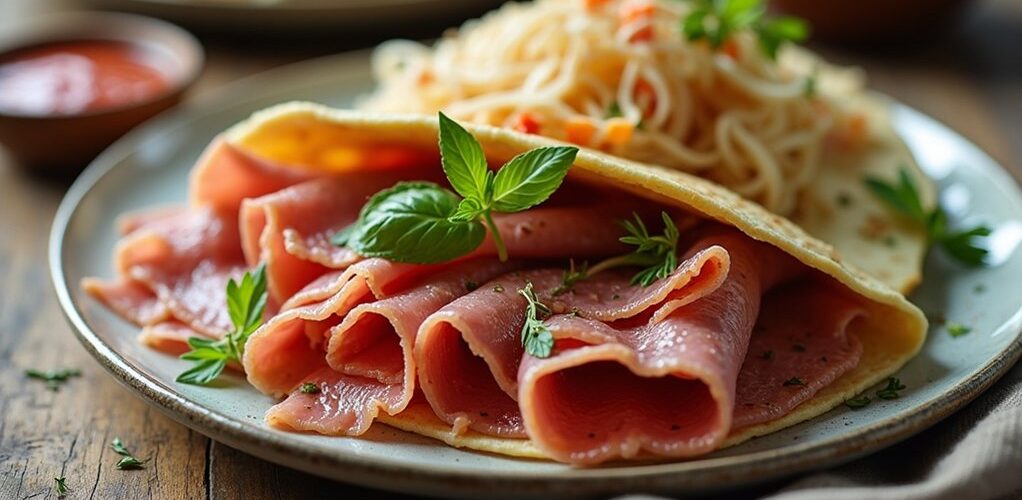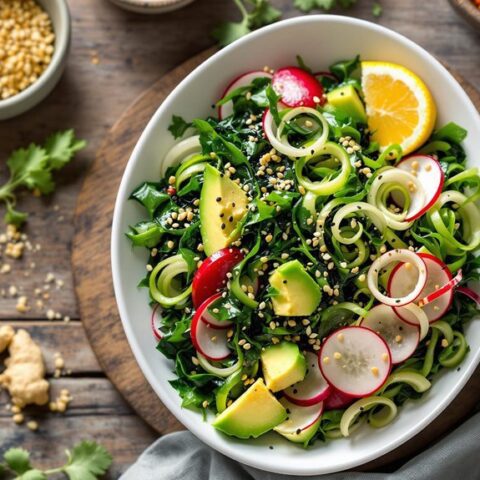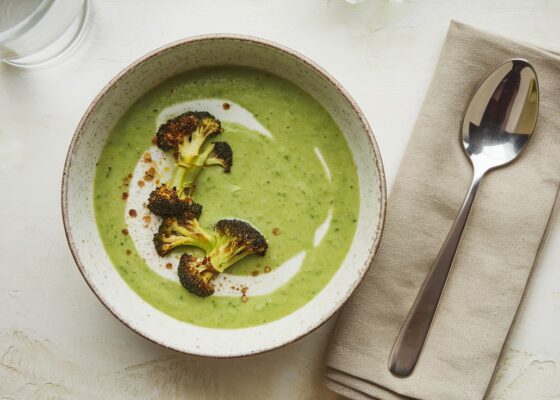
Gyro meat is inherently low in carbohydrates, containing only 2 grams per serving, which makes it an excellent choice for ketogenic and low-carb diets. The traditional combination of lamb or beef, seasoned with herbs and spices, provides approximately 25 grams of protein while maintaining minimal carb content. While traditional accompaniments like pita bread are high in carbs, alternatives such as lettuce wraps and tzatziki sauce can create a satisfying, low-carb Mediterranean meal. Understanding the proper preparation and ordering techniques reveals the full potential of this versatile street food.
Key Takeaways
- Traditional gyro meat contains only 2 grams of carbohydrates per serving, making it an excellent choice for low-carb and ketogenic diets.
- While gyro meat itself is low-carb, traditional accompaniments like pita bread can add significant carbohydrates to the meal.
- Lettuce wraps and cauliflower rice provide low-carb alternatives to pita bread while maintaining the authentic gyro experience.
- Gyro meat's 80/20 to 70/30 meat-to-fat ratio delivers optimal flavor and nutrition without adding unnecessary carbohydrates.
- Tzatziki sauce made with Greek yogurt adds authentic flavor while keeping carbohydrates low, especially when served on the side.
Understanding Traditional Gyro Meat Composition
When examining the composition of traditional gyro meat, one discovers a protein-rich combination of carefully selected meats and seasonings.
The foundation of this Mediterranean staple consists primarily of lamb, beef, or a blend of both, making it an excellent choice for those following a low-carb diet.
Traditional gyro preparations incorporate seasoned herbs and spices, including oregano, garlic, and cumin, which enhance flavor without adding carbohydrates to the dish.
The meat is carefully stacked and slow-roasted on a vertical spit, creating a crispy exterior while maintaining succulent interior layers.
With approximately 25 grams of protein per serving, gyro meat offers substantial nutritional value while remaining naturally low in carbohydrates, particularly when enjoyed without traditional high-carb accompaniments like pita bread.
Increased protein intake helps maintain muscle mass and enhances feelings of fullness, making gyro meat a satisfying option for those on a low-carb diet.
Carbohydrate Content Analysis of Gyro Meat
A detailed analysis of gyro meat's carbohydrate content reveals its natural alignment with low-carb dietary goals. With only 2 grams of carbohydrates per serving, traditional gyro meat, whether made from lamb or beef, stands as an excellent choice for those monitoring their carb intake. The protein-rich nature of gyro meat, delivering approximately 25 grams of protein per serving, makes it a substantial meal component while maintaining minimal carbohydrate impact. While traditional gyro presentations often include high-carb elements like pita bread, the meat itself remains remarkably low in carbohydrates. Health-conscious diners can enhance their gyro experience with low-carb alternatives, such as tzatziki sauce, which adds flavor and beneficial probiotics without considerably affecting the overall carbohydrate content of the meal. Additionally, incorporating gyro meat into a ketogenic diet can aid in stabilizing blood sugar levels and improving insulin sensitivity, making it a suitable option for those managing type 2 diabetes.
Health Benefits of Greek-Style Gyro Proteins
Greek-style gyro proteins offer substantial nutritional benefits that extend far beyond their satisfying taste profile. With approximately 25 grams of protein per serving, gyro meat provides essential nutrients for muscle development and repair, making it an excellent choice for health-conscious individuals seeking low carb alternatives. The high-protein content works alongside beneficial unsaturated fats that help reduce bad cholesterol levels, supporting cardiovascular health. Additionally, the iron-rich composition of Greek-style gyros helps prevent anemia and combat fatigue by promoting efficient oxygen transport throughout the body. When combined with fresh vegetables, gyro meat delivers an extensive array of vitamins and minerals, while its adaptability to various dietary needs makes it an ideal protein source for those following specific nutritional plans. Gyro meat, much like fresh meats and poultry, offers a carb-free protein source, making it perfect for keto dieters.
Low-Carb Gyro Preparation Methods
Creating a low-carb gyro begins with mastering the assembly technique, which eliminates traditional pita bread in favor of lettuce wraps or protein-based alternatives. The ideal meat-to-fat ratio for gyro meat typically ranges between 80/20 and 70/30, ensuring the mixture remains juicy and flavorful while maintaining its structural integrity. Seasoned cooks recommend incorporating crushed pork rinds or keto-friendly breadcrumbs as binding agents, which help achieve the characteristic dense texture without adding unnecessary carbohydrates. To keep your keto gyro delicious and nutritious, consider using leafy greens such as spinach or kale for added flavor and essential vitamins.
No-Bread Gyro Assembly
Making delicious low-carb gyros without traditional pita bread opens up exciting possibilities for health-conscious diners. The assembly process begins with selecting a fresh lettuce leaf or bed of cauliflower rice as the foundation. Traditional Greek gyro meat is layered on top, followed by a vibrant combination of cucumber, tomato, and red onion relish. A generous drizzle of tzatziki sauce and sprinkle of feta cheese complete this Mediterranean masterpiece.
| Component | Low-Carb Option | Benefits | Preparation |
|---|---|---|---|
| Base | Lettuce/Cauliflower Rice | Minimal Carbs | Wash/Steam |
| Protein | Gyro Meat | High Protein | Slice/Heat |
| Toppings | Greek Relish | Fresh Nutrients | Dice/Mix |
| Sauce | Tzatziki/Feta | Probiotics/Calcium | Combine/Sprinkle |
Meat-to-Fat Ratio Tips
The perfect meat-to-fat ratio stands as a cornerstone of successful low-carb gyro preparation, with the ideal proportion falling around 73% lean meat to 27% fat content. This balance guarantees optimal flavor and texture while maintaining the dish's low-carb integrity.
Whether using ground lamb or beef, selecting meat with appropriate marbling contributes greatly to the final product's juiciness.
For the meat mixture, incorporating crushed pork rinds as a binding agent offers a practical low-carb alternative to traditional breadcrumbs. The addition of spices and fresh herbs not only enhances the overall flavor profile but also complements the natural richness of the marbled meat.
After cooking, pressing the meat to remove excess fat helps achieve the desired texture for authentic gyro slicing, while preserving the essential fats that carry flavor.
Best Practices for Ordering Keto-Friendly Gyros
Steering a gyro menu while maintaining ketogenic dietary requirements demands strategic ordering choices and careful attention to ingredients. For a low-carb gyro experience, request the lamb or beef without pita bread, and consider lettuce wraps as an alternative. The tzatziki sauce adds authentic flavor while providing probiotic benefits, though it's wise to request it on the side to control portions. It is important to remember that the keto diet improves insulin sensitivity and can aid in managing Type 2 diabetes effectively.
| Component | Keto-Friendly Option | What to Avoid |
|---|---|---|
| Bread | Lettuce wraps | Pita bread |
| Meat | Lamb or beef | Processed fillers |
| Sauce | Tzatziki (moderate) | Sweet dressings |
| Sides | Extra vegetables | Rice, potatoes |
These modifications allow diners to enjoy the authentic flavors of gyros while maintaining their keto-friendly dietary goals.
Essential Ingredients for Homemade Low-Carb Gyros
Creating authentic low-carb gyros at home requires a careful selection of traditional Mediterranean spices, including oregano, rosemary, thyme, and garlic, which contribute essential flavors without adding carbohydrates.
For the meat base, selecting high-quality ground lamb or beef with a fat content between 80-20 and 70-30 guarantees the proper texture and moisture retention during cooking.
Crushed pork rinds serve as an excellent low-carb binding agent, replacing traditional breadcrumbs while maintaining the characteristic firm yet tender texture of authentic gyro meat.
Incorporating healthy fats from sources like olive or avocado oil enhances the flavor and nutritional quality of the gyro meat while supporting the low-carb, high-fat requirements of a keto diet.
Traditional Spice Blend Components
Mastering the traditional spice blend lies at the heart of creating authentic, low-carb gyros that capture the essence of Mediterranean cuisine. The classic Greek gyro seasoning combines oregano, thyme, garlic powder, onion powder, and cumin, creating a distinctive flavor profile that defines this beloved street food.
Fresh herbs like parsley and dill complement these core spices, enhancing both taste and aroma.
Beyond flavor enhancement, these spices offer significant health benefits, including anti-inflammatory properties and antioxidant effects. When preparing low-carb gyros, maintaining this traditional spice blend while using carb-conscious ingredients guarantees authenticity without compromising dietary goals.
The blend can be customized to personal preferences while preserving the fundamental characteristics of genuine gyro meat, making it adaptable for various dietary requirements.
Meat Selection Guidelines
The selection of proper meat cuts stands as the cornerstone of crafting authentic, low-carb gyros at home. For best results, traditional ground lamb or beef with a higher fat content, typically an 80/20 ratio, delivers the ideal flavor and texture profile while maintaining minimal carbohydrate content.
When preparing low-carb gyros, cooks should avoid lean alternatives like turkey or chicken, which can compromise both taste and texture. Instead, focusing on fattier cuts guarantees a juicier, more authentic result.
To maintain the proper structure of the meat mixture, incorporating crushed pork rinds serves as an effective low-carb binding agent. The combination of carefully selected meat and proper seasoning with Mediterranean spices creates a satisfying gyro that aligns perfectly with low-carb dietary requirements.
Low-Carb Binding Options
Several low-carb binding alternatives offer excellent solutions for maintaining the structural integrity of homemade gyros without relying on traditional breadcrumbs. Crushed pork rinds serve as an effective binding agent when combined with ground lamb and beef mixtures, creating a cohesive texture while keeping carbohydrates minimal.
This adaptation preserves the authentic Mediterranean flavor profile while adhering to low-carb dietary requirements.
When crafting homemade gyros, the binding ingredients work in harmony with fresh herbs and spices to enhance the overall taste. The meat mixture pairs perfectly with tzatziki sauce made from Greek yogurt or full-fat sour cream, creating a satisfying combination that maintains the classic gyro experience.
This thoughtful selection of binding alternatives guarantees the meat stays firmly together during cooking and slicing, resulting in restaurant-quality gyros suitable for low-carb dining.
Alternative Low-Carb Wrapping Options
Health-conscious diners seeking to enjoy gyros while maintaining a low-carb lifestyle can explore numerous alternatives to traditional pita bread. Large lettuce leaves offer a fresh, crunchy option that adds virtually no carbohydrates to the meal, while providing a natural wrap for gyro ingredients. For those preferring a more bread-like experience, keto flatbreads made from almond or coconut flour create a satisfying alternative that maintains the familiar handheld format. Creative options like zucchini slices and egg-based crepes provide additional variety, each bringing unique textures and nutritional benefits to the dish. Cauliflower rice serves as an excellent base for deconstructed gyro bowls, allowing diners to enjoy all the traditional flavors while keeping carbohydrate content minimal. Additionally, Shirataki Noodles, known for their low carb content, can be used as a base for gyro bowls, adding a different texture and maintaining the dish's low-carb profile.
Nutritional Breakdown and Macros
When examining the nutritional profile of gyro meat, diners following low-carb diets will find it particularly suitable for their needs, containing just 2-6 grams of carbohydrates per serving. The nutritional breakdown reveals impressive protein content, ranging from 22-56 grams per serving, while the fat content varies between 15-56 grams, mainly from beneficial unsaturated fats. Gyro meat aligns well with the principles of the ketogenic diet, as its low carbohydrate content helps maintain ketosis and support fat burning.
| Nutrient | Amount per Serving | Diet Impact |
|---|---|---|
| Carbs | 2-6g | Low-carb friendly |
| Protein | 22-56g | Muscle supporting |
| Fat | 15-56g | Energy sustaining |
While traditional gyro meat maintains its low-carb status, it's essential to note that preparation methods and additional ingredients can affect the final nutritional values, particularly when incorporating sauces or traditional bread accompaniments.
Mediterranean Diet-Friendly Modifications
Traditional Mediterranean cuisine offers numerous opportunities to modify gyro recipes while maintaining their authentic flavors and low-carb benefits.
By incorporating ground beef or lamb with crushed pork rinds as a binder, the meat mixture remains faithful to Mediterranean flavors while keeping carbohydrates minimal. The addition of tzatziki sauce not only preserves the classic taste but also introduces beneficial probiotics through Greek yogurt. Including non-starchy vegetables like spinach and kale provides essential vitamins and minerals while keeping the meal low in carbs, making them ideal for keto meals.
For those following a low-carb lifestyle, Mediterranean-inspired modifications can include serving the gyro meat over fresh vegetables instead of pita bread.
Traditional toppings like feta cheese and olives complement the dish perfectly, adding healthy fats and essential nutrients without compromising carbohydrate restrictions.
These adaptations allow diners to enjoy authentic Mediterranean flavors while adhering to their dietary preferences.
Frequently Asked Questions
Can I Eat Gyro on a Low-Carb Diet?
Gyro meat itself supports low-carb diets when served without pita. Using low-carb alternatives like lettuce wraps, adding healthy toppings, practicing portion control, and planning meal prep maintains dietary goals.
Are There Any Carbs in Gyro Meat?
Gyro meat ingredients typically contain minimal carb content, with approximately 2 grams per serving. The meat's nutritional value primarily consists of high protein levels, making it suitable for carb-conscious diets.
Is Greek Gyro Meat Healthy?
Gyro meat provides significant health benefits, including high protein content and essential nutrients. Nutritional analysis shows positive attributes when prepared with lean meats, though portion sizes and cooking methods impact overall healthiness.
Can You Have Gyro Meat on Mediterranean Diet?
Gyro meat aligns with Mediterranean diet principles when prepared traditionally and served in controlled portions. Combined with healthy toppings like vegetables and tzatziki, it provides protein and nutrients while maintaining the diet's balanced approach.
Conclusion
Traditional gyro meat proves to be an excellent low-carb option when prepared and ordered thoughtfully. By focusing on the protein-rich meat components and selecting appropriate accompaniments, diners can enjoy this Greek street food staple while maintaining ketogenic or low-carb dietary goals. Whether dining out or preparing gyros at home, understanding ingredient composition and making informed substitutions allows enthusiasts to savor authentic Mediterranean flavors without compromising their nutritional objectives.










No Comments